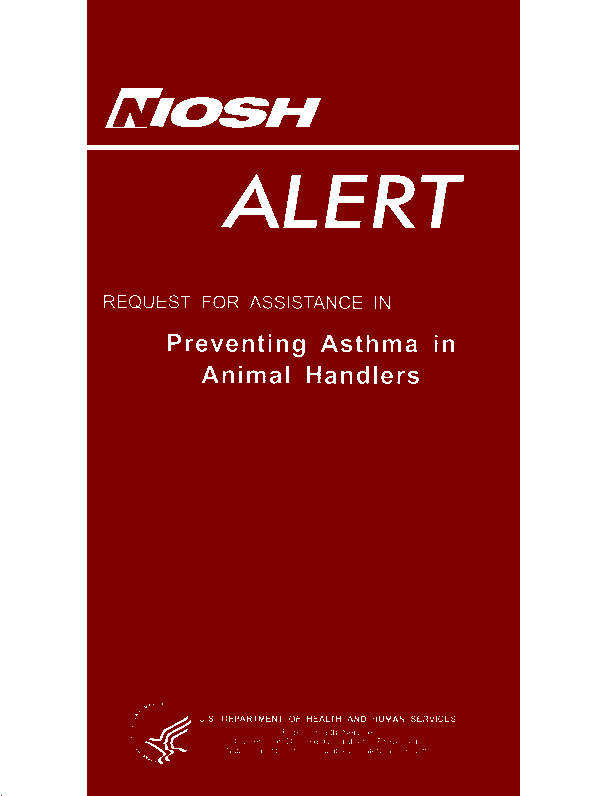Preventing Asthma in Animal Handlers
January 1998
DHHS (NIOSH) Publication Number 97-116

WARNING! Exposure to animals or animal products in the workplace can cause asthma and allergies.
Animal handlers should take steps to protect themselves from exposure to animals and animal products:
- Perform animal manipulations within ventilated hoods or safety cabinets when possible.
- Avoid wearing street clothes while working with animals.
- Leave work clothes at the workplace to avoid potential exposure problems for family members.
- Keep cages and animal areas clean.
- Reduce skin contact with animal products such as dander, serum, and urine by using gloves, lab coats, and approved particulate respirators with faceshields.
Employers of animal handlers should take steps to protect workers from exposure to animals and animal products:
- Modify ventilation and filtration systems:
- Increase the ventilation rate and humidity in the animal-housing areas.
- Ventilate animal-housing and -handling areas separately from the rest of the facility.
- Direct airflow away from workers and toward the backs of the animal cages.
- Install ventilated animal cage racks or filter-top animal cages.
- Decrease animal density (number of animals per cubic meter of room volume).
- Keep cages and animal areas clean.
- Use absorbent pads for bedding. If these are not available, use corncob bedding instead of sawdust bedding.
- Use an animal species or sex that is known to be less allergenic than others.
- Provide protective equipment for animal handlersgloves, lab coats, and approved particulate respirators with faceshields.
- Provide training to educate workers about animal allergies and steps for risk reduction.
- Provide health monitoring and appropriate counseling and medical followup for workers who have become sensitized or have developed allergy symptoms.
The National Institute for Occupational Safety and Health (NIOSH) requests assistance in preventing asthma and allergies in animal handlers. Approximately 2 million workers have jobs that require constant contact with animals or animal products [Brooks 1992]. About 33% of animal handlers have allergic symptoms, and approximately 10% have symptoms of animal-induced asthma [Chan-Yeung and Malo 1994]. Animals or animal products such as dander, hair, scales, fur, saliva, and body wastes contain powerful allergens that can cause both respiratory and skin disorders. Workers at risk include laboratory animal and veterinary technicians, researchers, veterinarians, and others who have prolonged, close association with animals or their secretions or excretions. Also at risk are workers who handle animal products or associated materials such as bedding and feed.
This Alert describes three case reports of workers affected by exposures to animals. The recommendations presented here can help reduce such exposures and prevent animal-induced asthma and allergies.
Background
Animal-related asthma and allergies are exaggerated reactions of the body's immune system to animal proteins, also known as allergens. Sources of these allergens include animal dander, scales, fur, body wastes, and saliva [Bardana 1992; Lincoln et al. 1974].
Inhalation is one of the most common ways for allergens to enter the body. After a period of time (often several months, but occasionally many years), workers may inhale sufficient quantities of allergens to become sensitized that is, they develop symptoms when exposed again, even to tiny amounts of the allergen [Bardana 1992; Chan-Yeung and Malo 1994]. Airborne exposures to dusts derived from animals are not currently regulated to protect workers from developing allergic problems.
The diagnosis of animal allergy or sensitization is made using skin-prick tests, blood antibody tests, and other methods. Symptoms vary among workers who have become sensitized to animals. Mild reactions include sneezing and runny nose. More serious reactions to an inhaled allergen may result in asthma symptoms such as cough, chest tightness, wheezing, or shortness of breath. In sensitized workers, reactions often occur soon after exposure to the animal or animal product, but they may be delayed for 2 to 8 hours or more.
A worker who has developed asthma symptoms from animal allergies often improves or recovers completely if he or she immediately stops being exposed to dusts containing the animal allergens. However, the longer the exposures continue, the more likely the illness will persist, even after all contact with animals has stopped.
Symptoms from animal-related asthma and allergies can be severe and may require affected workers to change jobs or careers [Bardana 1992]. Affected workers and their employers must bear the costs for treatment, time lost from work, and temporary or even permanent disability [Newill et al. 1986].
Common Sources of Exposure
Sources of exposure to animal allergens vary with animal species. For example, the most important allergens have been found in the urine of rats and in the urine, saliva, and pelts of guinea pigs [Chan-Yeung and Malo 1994]. Rat urine contains significant amounts of a protein that is also found in dust samples from ventilation systems of animal facilities [Bardana 1992]. Other important sources of allergen exposure include rabbit pelts, cat saliva and dander, dog dander, and horse serum and dander [Bardana 1992].
Exposures to rats, mice, and rabbits have frequently been associated with the development of occupational asthma. Species other than mammals have also been reported to cause respiratory symptoms of various insects, for example, and frogs (which are commonly used in science classes) [Bardana 1992]. Exposures to birds have been associated with other respiratory diseases, including hypersensitivity pneumonitis [Parker et al. 1992]. A person who becomes allergic to one animal species may react to other species as well. Even a low exposure to these common sources of animal allergens can result in allergies, but the risk increases as the worker's exposure increases [Hollander et al. 1997].
Disclaimer
Mention of any company or product does not constitute endorsement by the National Institute for Occupational Safety and Health.
This document is in the public domain and may be freely copied or reprinted.
- Page last reviewed: June 6, 2014
- Page last updated: June 6, 2014
- Content source:


 ShareCompartir
ShareCompartir